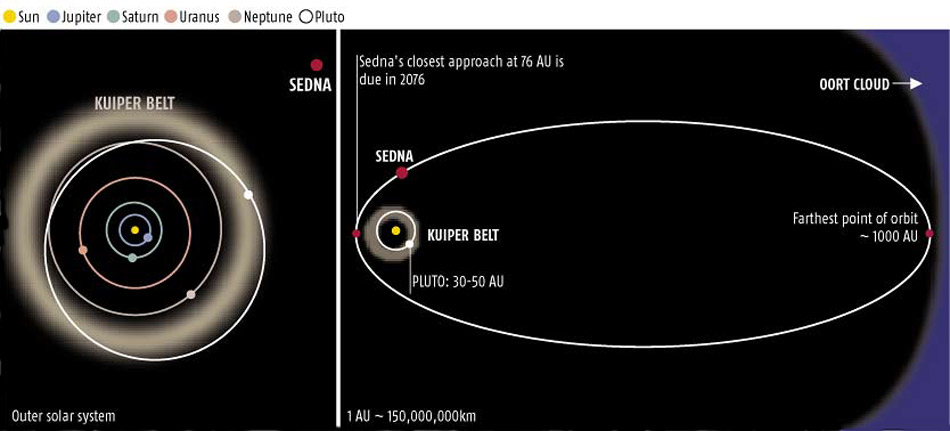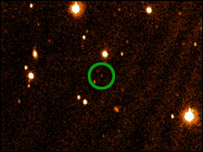90377 Sedna

Sedna's orbit compared with those of the Pluto, and the Kuiper Belt.

Sedna comparative size.
Sedna is a trans-Neptunian object: one of the two most distant large objects yet found orbiting the Sun (the other being 2012 VP-113). Its precise classification remains uncertain. The Minor Planet Center currently classifies it as a Scattered Disk Object, while others place it at the inner margin of the Oort Cloud. Sedna, named after the Inuit goddess of the ocean, is currently three times further away than Pluto, the average distance of which from the Sun is 5.9 billion kiloetersm (3.6 billion miles). At its most distant, Sedna is almost 150 billion km (93 billion miles) from the Sun, or 990 times Earth's solar distance. It has an obital period, or year, of some 10,500 years. Its surface temperature is believed to be about –240°C (–400°F).
 |
| Artist's impression of Sedna
|
Sedna, originally designated 2003 VB12, was first seen on 14 November 2003 with the 48-inch Samuel Oschin Telescope at California's Mount Palomar Observatory. Astronomers from the California Institute of Technology, Yale University, and the Gemini Observatory were involved in the discovery. Observations show it has a diameter of 995±80 kilometers (620±50 miles) in diameter, which is smaller than Pluto. Sedna has a high albedo and very red – the reddest large object in the Solar System after Mars. Its size suggests it should not be classified as a true planet, although there is disagreement among astronomers on this point and there are no hard and fast rules about what counts as a planet, planetoid, or minor planet. Sedna rotates more slowly on its axis than expected, suggesting it may have a satellite orbiting it.
 |
| Sedna discovery photo
|
Sedna is probably half-rock and half-ice but further observations will be needed to confirm this. Although Sedna could be a so-called Kuiper belt object (KBO), its discoverers have cast doubt on this. The object's elliptical orbit is unlike anything previously seen by astronomers. It could be the first detection of the long-hypothesized Oort cloud, a faraway repository of small icy bodies that supplies some of the comets that streak by Earth. This cloud is believed to surround the Sun and extend outward at least a third of the way to the nearest star. But Sedna is 10 times closer than the predicted distance of the Oort cloud. Sedna might belong to an inner Oort cloud that could have formed by gravity from a rogue star near the Sun in the Solar System's early days. Early in the history of the Solar System there must have been many more stars very close to the Sun than there are now – stars that were born in the same cluster as the Sun.
Sedna's perihelion distance (closest approach to the Sun) is particularly interesting at 76 AU. This means that it is effectively beyond the scattering influence of Neptune, which makes it unlike the classical KBOs, and also unlike the scattered KBOs. It is most similar, dynamically, to the object cataloged as 2000 CR105 (semimajor axis 227 AU, eccentricity 0.805, inclination 22.7), which has perihelion at 44 AU, also outside Neptune's reach, and which has been discussed in papers by Gladman et al (Icarus 157, 269, 2002) and Emel'yanenko et al (Monthly Notices RAS, 338, 443, 2003). Other objects have larger aphelia than Sedna's 990 AU (e.g. Kuiper Belt Object 2000 OO67, with aphelion at 1010 AU) and many comets travel to larger distances.
In recent years, astronomical work has turned up several big objects beyond Neptune.
| diameter | 995±80 km |
| axial period | 0.42 days (10 hr) |
| perihelion | 76.0 AU |
| aphelion | 928 AU |
| semimajor axis | 502 AU |
| orbital period | ~11,249 years |
| orbital inclination | 11.9° |
| eccentricity | 0.849 |


